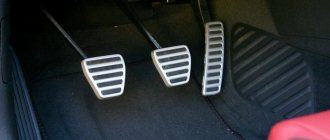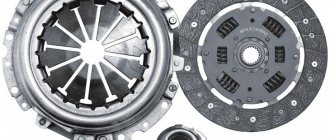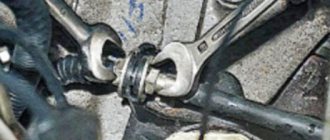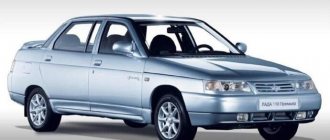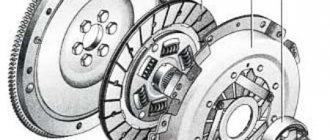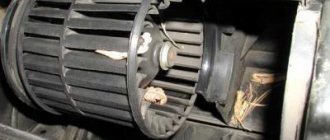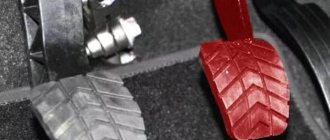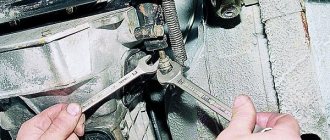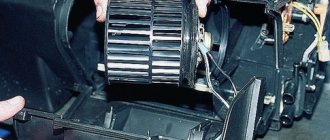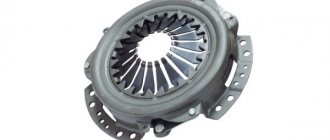Why did the pedal start to fail?
In most cases, the reasons for this malfunction are the following:
- The cable connecting the pedal to the tip is broken.
- There is a burst or cracked release spring.
- One of the clutch elements is oily. This could be a flywheel, a pulley, or friction linings.
- Quite often the cause is general wear and tear of the clutch system.
- The clutch drive is damaged.
- Unadjusted pedal mechanism.
As you can see, the list is large, but not all problems here are critical and complex. For example, in the case of excess oil, it will simply be enough to clean and grind the parts.
In the first and second cases, it is necessary to completely replace the failed parts - cable or spring.
Typical Ford Focus II clutch malfunctions
Let's look at the cases in which Ford Focus 2 clutch replacement
or repair of its individual components:
- incomplete shutdown;
- incomplete inclusion;
- increased noise when the clutch is engaged;
- vibrations;
- Difficulty shifting gears.
Craftsmen recommend installing all new parts at the same time, and not just worn-out ones. This is explained by the labor-intensive nature of the process, and the service life of undamaged structural elements has already been reduced and they will soon also require replacement. The owner decides what to do.
How to get to the nearest service station or home if the clutch pedal has failed?
The task, although not easy, is still quite realistic. The main thing here is to get going and not take your foot off the gas, maintaining the speed in first gear.
You need to proceed as follows
We warm up the engine, turn on the emergency lights, then turn on first gear, and turn the key in the ignition. When the engine starts to “catch”, give the gas and start moving. With the right approach, the car will not stall, and you will be able to move away and slowly get to your destination. Don't try to change gear without a clutch - it is certainly possible, there is a technique, but without the proper skill you will most likely stall or damage your transmission.
Now you know why the clutch pedal does not return, for what reasons this happens and how to solve this problem. In addition, if this happens, you will know how to get home if the VAZ clutch pedal fails. That's all for me, write in the comments how you solved this problem and what signs of malfunction you had and the cause of the breakdown. Thank you all for your attention and see you again at VAZ Repair. Bye.
The clutch pedal has failed, how to solve the problem?
If a breakdown is detected, try to restore the device’s functionality using one of the following methods:
1. Change the cable. To complete the work, prepare a set of wrenches, pliers and a replacement cable. It’s good if you have an open-end or socket wrench at hand (it’s more convenient with them).
Then proceed like this:
- Raise the hood of the car.
- Find the place where the cable is fixed to the tip.
- In case of breakage, remove the tip using a wrench.
- Go to the interior and remove the cable from the pedal, then pull it towards you and remove it completely.
- Take a new part and install it in place of the damaged cable. At the same time, assemble the mechanism using the reverse algorithm.
After completing the work, adjust the pedal travel. Set free play (30 mm) and total travel (about 147 mm).
Clutch pedal adjustment
2. Replace the spring. If the clutch pedal does not return due to a broken spring, proceed as follows:
- Prepare the spring. It is advisable to have it at hand. Otherwise, you will have to go to the store to buy.
- Lift the hood cover and unscrew the cable nut.
- Remove the old spring.
- Take the new element and put it in place. Be careful to avoid damage. Start the engine and drive 100-200 meters. If there are no clutch problems, continue driving.
Important points when replacing the cable
Unscrewing the fastener
- As practice shows, the procedure for replacing a cable on a “ten” begins in the engine compartment. You are required to hold the fork and at the same time pull the cable that is removed from the fork.
- Then the cable fastener is removed from the bracket, which is located on the gearbox. Having completed this procedure, we go into the interior and dismantle the damaged element, that is, the cable.
- The result of the repair is influenced not only by the quality of the new cable, but also by the correctness of the entire replacement procedure.
- If you are dealing with a “ten” from an experimental industrial batch, then the bracket will be presented as a bolt with a Phillips-head screwdriver. To dismantle such a fastening element, you cannot use a regular screwdriver. A special shortened tool will be required.
- If the cable breaks while driving, you can unscrew the bracket with a handy tool, but through the safety block.
- It is strongly recommended to replace the non-standard bolt with a regular one, which can be unscrewed with a simple wrench.
- Be sure to keep a set of tools in your car, since it is extremely rare for a cable to break at the right moment. There is hardly a right moment for any kind of machine breakdown.
Driving without a clutch: what you need to know
Taking into account the fact that most breakdowns that are associated with the clutch or clutch pedal (for example, the clutch pedal has failed) can take the driver by surprise, and it is often impossible to fix problems on the spot, the only option is to drive to the service station under your own power.
At the same time, we draw your attention once again to the fact that the methods described below should be used only in cases of extreme necessity, since the risk of damaging the box or getting into an accident increases significantly.
- So, first you need to turn off the car engine. If you lose traction on a hill, you should push the car onto a level road. Then it is recommended to think over the route in advance so that, if possible, you travel along a route with a minimum number of traffic lights, pedestrian crossings, not congested with traffic, so that you do not have to stop often, etc.;
- Next, with the engine turned off, you should engage first gear, and you also need to turn on the emergency lights, after which the engine can be started (note that the car will jerk forward sharply immediately after turning the key in the ignition switch to the “start” position);
Why does the brake pedal fail when braking and what to do?
Is your car suddenly having problems with its brakes? There is no need to panic. There are special techniques that will help you gradually slow down and stop the car even in this case. The most useful tool in this case is the parking brake, or “handbrake”.
It can slow down and stop the car if it was traveling at a speed of 20–40 km/h. But if you have little driving experience, there is no need to suddenly raise the handbrake at medium and high speeds, especially when driving on a wet, icy or snowy road. Your car may skid, spin, be thrown off the road, into the oncoming lane, etc.
What to do if the gear shift mechanism does not work?
If the clutch pedal fails on a road with heavy traffic, you should not be nervous, but act calmly with a “cool head” and get to the nearest parking spot, or even better, to a garage or service station. To do this, you can use a tug, tow truck, or drive yourself.
How to drive independently if the clutch system breaks down?
You can use the following tips from proven car enthusiasts:
You can also drive to the repair site with a VAZ2106 or VAZ2107 car without a clutch, engaging second gear in the same way when starting to drive. Only in this case it is necessary to take into account some important nuances:
- the car should be either on a horizontal section or on a downhill slope, but not uphill. If the car goes uphill, then this method will not work; Before you start driving, you need to warm up the engine;
- Since the car will move in a lower gear no higher than second, you should carefully think through the route so that you do not have to stop at intersections, giving way or at traffic lights. If possible, take the main road and pull at the green light to avoid getting caught;
- it is necessary to check: whether the alarm system is turned on;
- It is important to remember that other road users do not know about your problem, so you need to maneuver less. If you don’t have time, it’s better to stop the car and then do this procedure again;
- when you don’t have confidence in your abilities, the optimal solution would be to call a tow truck or tug.
In VAZ cars with a rear-wheel drive wheel pair, the clutch mechanism is a separate hydromechanical unit that interacts between the power plants and the transmission.
What to do if the clutch pedal does not press?
- What to do if the clutch pedal does not press?
- General information about the car clutch
- Why doesn't the clutch pedal press?
- What to do if the clutch pedal does not press
- Reasons for the clutch pedal not returning
- How to fix clutch pedal not returning
The driver is in constant tension. This happens not only because movement on the road is quite dynamic, but also because some mechanism in the car may unexpectedly break down. This can happen both at the entrance to the house and far from it. Traditional troubles on the road are brake failure and clutch problems. Very often on car forums you can come across the following question: why the clutch pedal does not press or is stuck, and what to do next with it.
- General information about the car clutch
- Why doesn't the clutch pedal press?
- What to do if the clutch pedal does not press
- Reasons for the clutch pedal not returning
- How to fix clutch pedal not returning
General information about the car clutch
The clutch is located between the engine and gearbox. Its function is to connect and disconnect the flywheel input shaft, which is mounted on the engine crankshaft. A car clutch consists of the clutch itself and the drive mechanism. In turn, the clutch mechanism consists of a pressure, drive and driven discs, release levers, driven shaft, casing, housing, release bearing, and diaphragm. The drive mechanism consists of a fork, a rod, an adjusting fork and a clutch pedal.
Why and where do the pedals on the VAZ-2110 fail?
Tens clutch diagram. There was nothing new for those times!
Of course, everyone who drives a VAZ-2110 knows the structure of the single-plate dry clutch mechanism and its drive. As on all inexpensive cars, the simplest clutch is not activated hydraulically, but mechanically: we press pedal 9, the pedal pulls the cable, the cable drives the fork 4, and the fork pushes the release bearing 13, which acts on the blades of the pressure plate 6 The release disk is removed from the driven disk 7, the clutch is disengaged.
If at least one of the elements of this chain loses its properties (strength, elasticity, integrity), the pedal simply falls to the floor or the clutch does not disengage, partially or completely.
Let's look at the most common faults typical for machines of the tenth family.
Clutch release fork
The clutch fork either bends or cracks the lever, or the legs wear out at the points of contact with the bearing coupling.
It’s not for nothing that we started rating faults not with the cable, which would be more logical to assume, but with the fork. The design and materials of this element are chosen so poorly that some people manage to change 3 plugs in a year . The symptoms of a breakdown are simple - a sudden drop in the pedal to the floor. In this case, the fork sometimes does not break completely, but breaks, creating the illusion of a whole element.
Typical clutch fork failure.
It’s easy to calculate the breakdown - open the hood and move the fork with your hands.
If it dangles freely, cracks or breaks are visible, we get to a spare parts store, buy a new fork and replace it; to replace it, you will have to partially remove the gearbox. The price of a new fork is no more than 500 rubles, and they sell it according to the factory article number 21100-1601200 . There are also cheaper forks on sale from other manufacturers, and there are reinforced designs that are more expensive.
How to get to the service station?
If the pedal fails and the house or garage is far away, proceed as follows:
- Set the gearbox selector to first speed mode. Do not press the gas pedal.
- Turn the ignition key in the lock. At the moment when the engine tries to start, you need to give a little gas. At this stage, it is important to ensure that the car does not stall.
- As soon as the vehicle starts moving, apply a little gas. It is highly not recommended to engage second gear, as this may lead to gearbox malfunction.
If the first gear does not engage for some reason, this method can be implemented with the second gear.
- If the clutch pedal fails while driving, try to stop the car on a downhill slope or at least on a flat and straight road. The main thing is that the vehicle does not stand on the hill and does not roll backwards.
- It is important to warm up the engine before driving. Before driving a car with a broken clutch, think about your route to the garage or service station. Consider the presence of intersections, the number of traffic lights, as well as all turns. Since you do not have the ability to change gears, it will be more convenient to travel along the main road with a minimum of pedestrian crossings.
- When driving, be sure to turn on your hazard lights.
- Eliminate unnecessary maneuvers, since other drivers do not know about your problem. In order not to create danger, it is better to stop once again and start moving again.
If the garage or nearest service station is quite a distance away, it may be advisable to call a tow truck or have the vehicle towed.
How to get to the car service
Don't despair and panic. Sometimes things aren't so bad. Even when the clutch pedal fails and fails, and no one can help, you need to follow several recommendations. There are a number of tips on what a driver should do in such a situation if the clutch fails.
- Do not panic. It’s strange, but this is precisely what motorists often simply forget about. Understand that you cannot do anything drastic with the clutch right here and right now while driving. Therefore, you need to concentrate, realize what is happening and continue to act according to the instructions. Panic has never helped anyone while driving.
- Try to restore the functionality of the clutch pedal. This doesn't always help, but it's worth a try. First you need to move the gear lever to neutral. At the same time, be sure to release the gas and take your foot off the accelerator pedal. When the pedal begins to sink, work the gas pedal a little. Sometimes this makes it possible to release the pedal and restore its functionality.
- Drastic measures. This is an option for situations where it is impossible to repair the clutch in the field. That is, you must definitely contact specialists. Here we have to act somewhat differently. Stop the engine and shift the gear lever to first speed. Now turn the starter until the engine starts. When the engine is activated, the car will begin to behave inappropriately. This is due to the fact that the work is carried out in a different gear than the one set on the box. To upshift, press the gas pedal, move the gearshift knob to neutral, and then shift to second speed. When performing such manipulations, try to do everything slowly. Gradually, moving at low speed, you can get to the nearest car service station under your own power.
It is recommended to resort to such measures only in extreme cases, when there is no other way to get to a service station and repair the clutch.
Please note that any sudden attempts to shift, as well as switching from gear to gear when the clutch is not working, threatens complete failure of the gearbox. So decide whether it’s worth the risk, or whether it’s easier to call a towing service for help.
